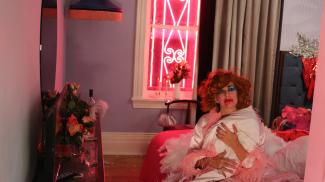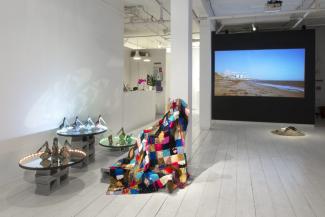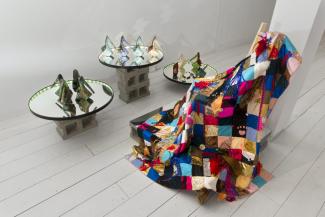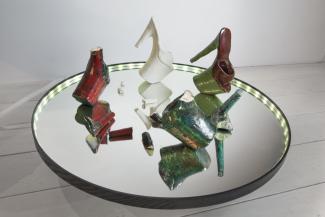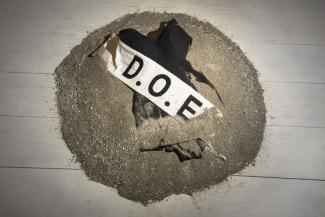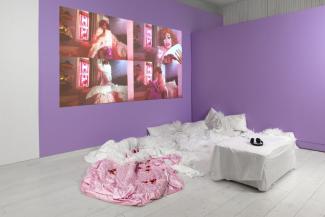A live performance and its documentation are often perceived as codependent, like the muscular and skeletal structures that form a jointed limb that stretches, points, and bends; parts together understood as Performance Art. According to Rosalind Krauss, the two must be considered as mutually functioning parts of a whole artistic genre.[1] While Krauss was referring to the role of photography and its direct, indexical relationship to the performances it represented, it is worth asking what relationship exists between non-photographic referents and a performance. What of no documentation at all? Performance art scholar Lee Campbell wrote that there exists “a tension between live performance and the need or requirement to leave a trace…[that] marks both the presence and the absence as an embodied process.”[2] Using materials and media-based remnants, the artists in Feathers, Ether, Sand, Speech interrogate these concerns, and what is affected by the presence or absence of the performing body, in spaces that are often highly gendered: the cinema, the landscape, and the strip club.
With Punching A Pillow Until the Sun Rises (2017), Elizabeth Milton brings a once live-feed performance full circle. When the piece was originally performed at the Gladstone Hotel in Toronto for the city’s annual Nuit Blanche Festival, Milton staged her twelve-hour durational performance apart from a live audience. The performance was live-streamed and viewable downstairs in the hotel’s ballroom. At once cathartic and melodramatic, Milton envelops the display of hyper-femininity with the famous soundtrack of Pyotr Ilyich Tchaikovsky’s 1875 ballet Swan Lake. The four channel split-screen emphasizes Milton’s interest in the relationship between live performance, documentation and mediated experience. The viewer watches the increasingly manic drama unfold in a seemingly never-ending display of what Milton refers to as “maximalist femininity,” a trope she often employs in her work. A series of representational registers and interfaces exist, between the viewer and performer, between live and recorded video, and between gender and its performance. Milton, in playing an exaggerated drag queen diva, “implicitly reveals the imitative structure of gender itself,” to quote Judith Butler.[3] What is gender if not a construction of tropes and performative gestures? What is drag if not a comical exaggeration of such archetypes of femininity, thus making the construct explicitly obvious?
Draped over a simple wooden chair, painted gold, reclines the glittering patchwork of Sydney Southam’s A Glorious Moment (2018). Accompanying the quilt is a series of raku fired ceramic pleasers, the iconic platform shoes worn by strippers and pole dancers and often used as an acoustic element in their performances. The pieces embody many of the emotional associations Southam has with her previous work as a professional stripper. A neck injury forced Southam to quit stripping in 2017, but her experience has become a powerful influence on her media art and performance practices. Through the creation of A Glorious Moment, Southam explored the materials’ ability to hold memory and meaning, and to forge new connections between labour and performance. Producing the work itself, she said, “[was] a true performance of making.” The quilt is made from donated costumes from dancers still working as strippers or who have also left the industry.[4] The raku ceramics, perched in the iconic ‘toe drag’ performed by strippers on stage, contradict the objects’ necessary sturdiness and powerful acoustics when whacked against the pole as the dancers perform. Southam’s work points to the dualistic relationship between the labour of stripping and normative gender representation. On the one hand, stripping is perceived as highly gendered and restrictive in its representations of female bodies. On the other, the embellishment of these feminized ideals in stripping, like Milton’s use of “maximalist femininity” in her drag performances, emphasizes the precarity of not only femininity, but the restricted expressions of masculinity as well. Southam works to reconcile her experiences in the stripping industry into the material practices of quilting and ceramics. She integrates these forms of labour and performative practices into a performance itself that is both present and yet distinct from the previous lives the objects once embodied, on a very different kind of stage.
Lauren Marsden’s work, Miss Department of Energy Has Left the Building, (2009-2018) evokes the aftermath of a bodily performance on the California beachfront. The discarded swimsuit and Miss D.O.E. sash sit in front of a deserted public shoreline, the remnants of a performative ritual that could have marked the opening of the nuclear power station. Invoking the sounds and textural details of the oceanfront landscape, the background slowly fades and drifts back into view. Much as the San Onofre Nuclear Generating Station in the background is no longer operational, the image fades, turns to black, before returning to the screen, dreamlike and ephemeral. The pile of sand and discarded costume remain as if captured in the moment after the inauguration of San Onofre in 1968.[5] With this referent, Marsden invokes what can be called the “evaporated performer,” the absence of the body whose presence is then only marked by the presence of materials or objects. Miss D.O.E., as she would have stood on the beachfront, is a symbolic referent to the ritualistic employment of female promotional models to mark the occasion of the opening of a structure, the advertisement of a product, or the distributing of medals and trophies at sporting events. Marsden interrogates the absence of the performing body, and the objects that must refer to the performance when no other documentation exists.
Together, these artists examine the relationships of objects and non-photographic documentation to live performance. With the absence of a performing body, Marsden and Southam emphasize the issues of gendered labour and symbolic female presence. Milton, presenting herself in a multi-framed confrontation of drama, explicates the fragility of gender, exploding its cinematic drama to the point of mania. For all three artists the integration of documentation, whether media or material based, draws on the embodied process that exists in the ether of performance works, regardless of whether a body is visible.
[1] Amelia Jones, “‘Presence’ in Absentia: Experiencing Performance as Documentation,”
Art Journal, Vol. 56, No. 4, Performance Art: (Some) Theory and (Selected) Practice at the End of This Century (Winter, 1997), pp.16.
[2] Lee Campbell, “Beyond Pollock: on visual art objects as non-traditional forms of performance document,” International Journal of Performance Arts and Digital Media, 10:1 (2014), pp 37.
[3] Judith Butler; Linda Williams, “A Provoking Agent The Pornography and Performance Art of Annie Sprinkle,”
in Writing on the Body: Female Embodiment and Feminist Theory, Ed. Katie Conboy (Columbia University Press. 1997): 374.
[4] For each costume donated to the project, Southam made a monetary donation in the dancer’s name to Women Against Violence Against Women (WAVAW), “a grassroots feminist organization that is dedicated to ending violence against women. [They] provide numerous services to survivors of sexual assault.” www.wavaw.ca
[5] While the presence of a model at the opening of San Onofre is merely hypothetical, a woman’s symbolic presence at the inauguration of similar structures and events points to the ritualistic use of women’s bodies to celebrate the accomplishments of male executives, athletes, and celebrities.
